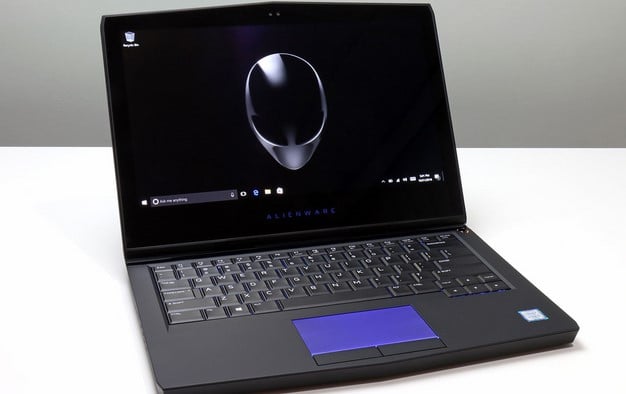Alienware 13 R3 Review: OLED, GeForce 10 Pop And Performance
A Deep Dive Look At The Alienware 13 R3
Dell's Alienware gaming PC division recently announced a refresh of their 13, 15 and 17 notebook product lines, starting with the introduction of their 15 and 17 inch models and more recently unchaining their smaller but just as scrappy 13-inch beast. While the new machines don't usher in Intel's latest Kaby Lake 7th Gen Core series processors (of which only dual-core variants are currently available), they are now packing NVIDIA Pascal firepower, with a GeForce GTX 1080, GeForce GTX 1070 and GeForce GTX 1060 powering the Alienware 17, 15 and 13 models respectively. It was a clean sweep for NVIDIA and the Alienware team also took the opportunity to tighten-up the build quality of their gaming notebook fleet, with new, cleaner lines and edgier angular looks now strapped with more aluminum alloy and less high density polycarbonate.
However, one of Alienware's new three amigos is a bit more stand-out than the others, perhaps. With the Alienware 13 R3 (marking the 3rd revision), Dell-Alienware has taken what was previously a dual-core only affair and made it quad-core capable. That extra CPU juice under the hood, coupled with a dramatically more powerful GeForce GTX 1060 GPU, should equate to a bodacious increase in gaming performance-per-square inch. And if that weren't enough, Alienware brought that sexy OLED back for the upper-end SKUs of the AW13 -- 13.3 inches of super-saturated, 1ms pixel response time love...
Let's face it, after this years crazy US Presidential Election cycle, you need a diversion. Alienware may just have a proper diversion for you here but first, let's hit the video roll and then we'll deep-dive into the particulars.
The configuration Alienware sent in for review is a top-of-the-line load-out with a Core i7-6700HQ quad-core Skylake CPU, a 512GB PCIe NVMe Solid State Drive, 16GB of RAM and a QHD (2560X1440) OLED (Organic LED) display. As tested, our machine retails for $2,124.99 as configured on Dell's site. However, you can dial in various build options starting as low as $1199, which would come with a standard FHD (1080p) IPS display and an Intel Core i5 quad-core processor. There are quite a few options on Dell's site but even the base model comes with 8GB of DDR4 2133MHz RAM and a GeForce GTX 1060, which by the way, offers virtually the same horsepower in the notebook configuration as its desktop counterpart. Power gating aside, the GPU and memory configuration are identical between NVIDIA's desktop and notebook variants, which is testament to the power efficiency of the Pascal architecture.
But let's poke and prod at this new alien machine a little more, shall we?
However, one of Alienware's new three amigos is a bit more stand-out than the others, perhaps. With the Alienware 13 R3 (marking the 3rd revision), Dell-Alienware has taken what was previously a dual-core only affair and made it quad-core capable. That extra CPU juice under the hood, coupled with a dramatically more powerful GeForce GTX 1060 GPU, should equate to a bodacious increase in gaming performance-per-square inch. And if that weren't enough, Alienware brought that sexy OLED back for the upper-end SKUs of the AW13 -- 13.3 inches of super-saturated, 1ms pixel response time love...
Let's face it, after this years crazy US Presidential Election cycle, you need a diversion. Alienware may just have a proper diversion for you here but first, let's hit the video roll and then we'll deep-dive into the particulars.
|
| Processor |
6th Gen Intel Core i7-6700HQ (6MB Cache, 2.6GHz - 3.5GHz) |
| Display | 13.3-inch QHD (2560x1440) OLED Display, 1ms, 60Hz |
| Graphics | NVIDIA GeForce GTX 1060 w/6GB GDDR5 |
| Memory | 16GB DDR4-2400 (8GB x2) |
| Storage | 512GB M.2 PCIe NVMe Solid State Drive |
| Optical | NA |
| Wired Ethernet | Killer Gaming Network E2400 |
| Wireless Connectivity | Killer Wireless AC 1535 2x2 WiFi with Bluetooth4.1 |
| Interface (Left) |
USB 3.0 With PowerShare), Headphone/Mic Line-In, Audio Line Out |
| Interface (Right) |
USB 3.0, USB 3.0 Type-C |
| Interface (Back) |
RJ-45 Killer Networks e2400, Mini DisplayPort 1.2 Output,HDMI 2.0, USB Type-C Thunderbolt, Alienware Graphics AMP Port, Power-Adapter Port |
| Webcam | Alienware HD resolution camera with IR presence detection and Windows Hello technology |
| Operating System |
Windows 10 Home 64-bit |
| Dimensions | 13.0 x 10.6 x .87 inches (W x D x H) |
| Weight | 5.8 Pounds |
| Extras | Tobii Eye Tracking Software, AlienFX™, AlienFusion™, AlienAdrenaline™ w/ Accelerator |
| Manufacturer Warranty |
Alienware 1 year Limited Warranty plus At-Home Service with additional extensions up to 4 years available |
| Pricing | $2,124.99 As Configured And Tested @ Dell.com |
The configuration Alienware sent in for review is a top-of-the-line load-out with a Core i7-6700HQ quad-core Skylake CPU, a 512GB PCIe NVMe Solid State Drive, 16GB of RAM and a QHD (2560X1440) OLED (Organic LED) display. As tested, our machine retails for $2,124.99 as configured on Dell's site. However, you can dial in various build options starting as low as $1199, which would come with a standard FHD (1080p) IPS display and an Intel Core i5 quad-core processor. There are quite a few options on Dell's site but even the base model comes with 8GB of DDR4 2133MHz RAM and a GeForce GTX 1060, which by the way, offers virtually the same horsepower in the notebook configuration as its desktop counterpart. Power gating aside, the GPU and memory configuration are identical between NVIDIA's desktop and notebook variants, which is testament to the power efficiency of the Pascal architecture.
But let's poke and prod at this new alien machine a little more, shall we?








